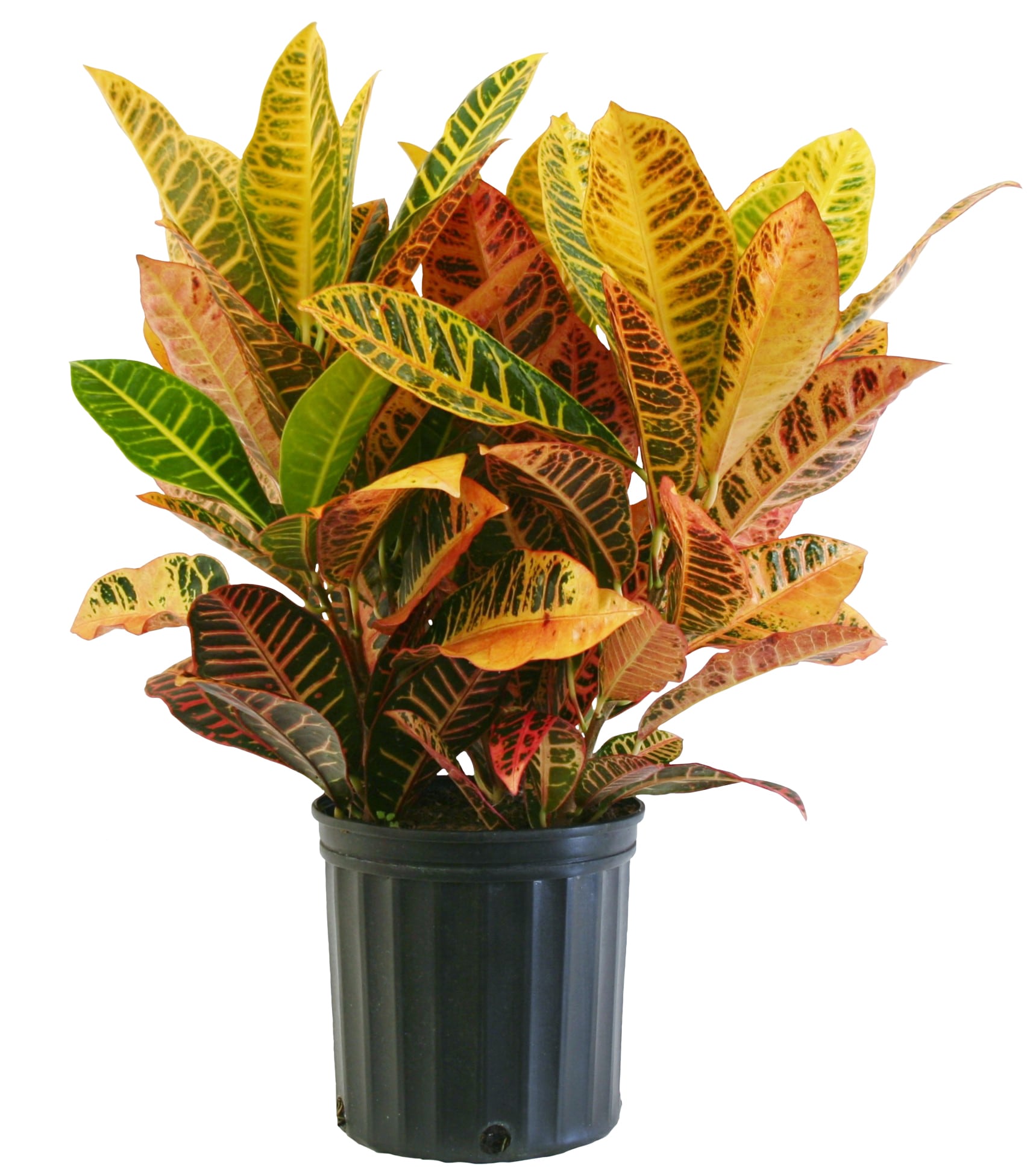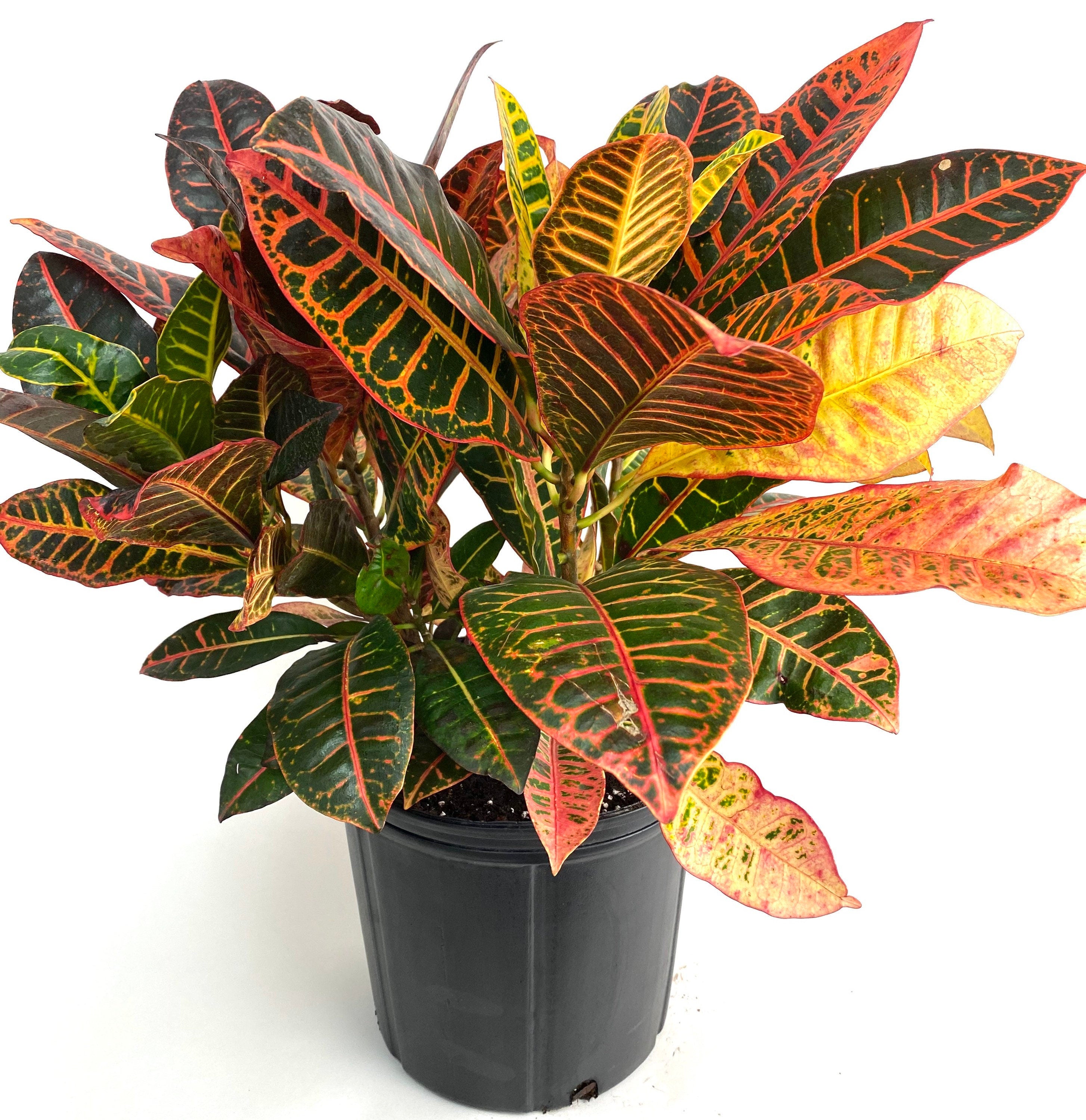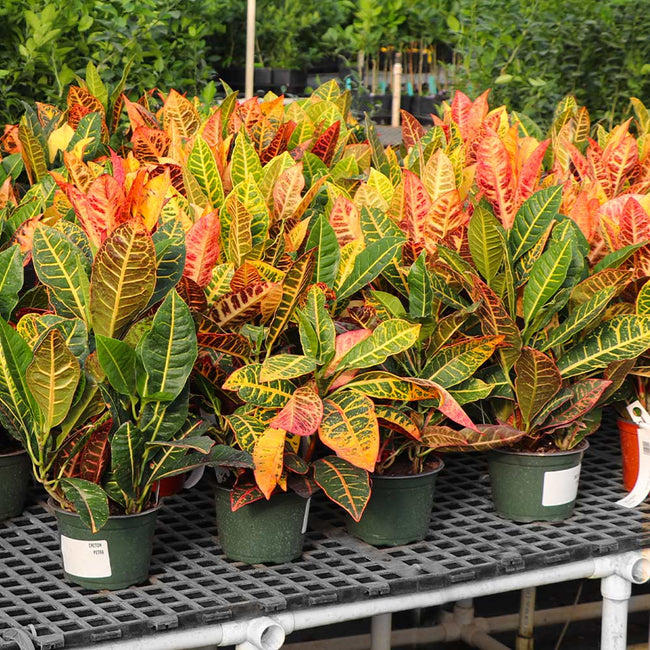
The Croton plant, also known as Codiaeum, is loved for the beautiful colors on its leaves. Most we know with yellow and red, but there are also white, orange and even purple Crotons available. Because of this beautiful appearance we also know the Croton under the nickname Wonder Shrub.Apart from the colors, the growth habit is also beautiful. The leaves grow in a straight line, which gives the plant a full appearance. Caring for the Croton is not very complicated. Read about the right approach on this page.
Table of Contents
Croton care
Habitat and light
Your Croton requires a position with a lot of direct sunlight. That makes this plant’s requirements different from many other popular houseplants, such as the Spoon plant. The Croton needs at least five hours of direct sunlight per day to stay beautiful. If the plant doesn’t get enough light, all kinds of problems arise: the leaves droop, the plant doesn’t make new leaves, and the colors of the leaves become less beautiful.
However, there is a side note to the amount of direct sunlight. Crotons are usually grown in a greenhouse. When you buy them, they often haven’t seen direct sunlight yet and they have to get used to it. So first give it a position with plenty of light and slowly build up the amount of sun. The same concept applies to other sun-lovers such as the Banana plant and the Strelitzia.It is normal for your Croton to lose a little of its color in the winter. After all, there is less sun and the sunlight present is not as strong as in spring and summer.
Watering a Croton
How much water does a Croton need? Just as much and as often as the plant is constantly in slightly moist soil. The emphasis here is really on “slightly moist.” That means never letting the soil dry out completely, and never keeping the soil soaking wet. This advice applies to the vast majority of houseplants, with the exception of succulents. It also applies to the beautiful Dieffenbachia, but how do you go about this? It goes like this:
- Stick a finger in the soil.
- Does soil stick to your finger? Then the soil is still too wet and wait to water the Croton.
- Does not soil stick to your finger? Then the soil is dry enough to water.
- Give about as much water as will be needed the next time after four days. This amounts to watering about twice a week.
It may sound complicated at first, but eventually this becomes routine. As mentioned above, most houseplants need to be watered this way and so the Croton can be included in the same routine.The right amount of water also varies by season. In general, a houseplant uses less water in the winter than in the spring and summer. The soil will also remain moist for longer, so it is important to water slightly less.
Incidentally, the plant gives signals about the amount of water. The Croton loses leaves? That is a sign that the plant has been given too much water for a long time. Dark or dry leaf edges are also a sign of too much water. On the other hand, drooping leaves are often a signal of a thirsty plant.
Codiaeum temperature
In the section on location it was already written that the Croton likes sun. These plants like to be warm. Too warm is actually not possible, unless this warmth is created “unnaturally” by, for example, a radiator. The warmth of the sun is always fine.
Problems can arise if the plant is exposed to temperatures that are too low. Never let the temperature go below 12 ℃. In most homes and offices this will not happen either, unless, for example, a window is open or the Croton is on the air flow of an air conditioner. This should be avoided. Too low a temperature will cause the Croton plant to drop its leaves.
Spraying the Croton
Keeping the Croton in optimal condition means regularly watering the plant’s leaves. To do this, set the plant sprayer to mist mode and mist the leaves until they are completely wet. This has several advantages:
- Bugs such as lice do not like to attach themselves to the Croton if it is regularly wet.
- Dust does not stay on the leaves as well. Less dust on the leaves means the plant can absorb more light. This in turn results in the colors on the leaves becoming and staying more beautiful.
Watering the Croton can be done with tap water. Be aware that tap water leaves white spots on the leaves after it dries. This is lime and completely harmless. You can easily wipe it off again.
Repotting Croton
How often this plant needs to be repotted depends on its growth rate. A Croton in the light and under good care grows a lot faster than one in a dark place. As soon as the pot is completely occupied by roots, and there is no more room for soil, it is time to repot. You will notice this if the soil has always dried out very quickly after watering and/or if the plant no longer grows well.
Always use new potting soil when repotting, then the plant can go forward for a while. It is important to read carefully for how long there is plant nutrition in the new potting soil. As long as it is there, it is important not to add extra nutrition.
Requirements for a pot
The only requirement for a flower pot is to have holes in the bottom. This will prevent water from accumulating around the roots and killing the Croton. This advice applies to many plants that are sensitive to this, such as the Yucca and the Dracaena. You can improve the drainage even further by placing a layer of hydro grains on the bottom of the pot before putting the plant in with soil.
Croton pruning
Pruning a Croton involves two possible actions. These can be performed both, or just one. This depends on what you want for the plant.
- If the Croton grows too tall, it can be pruned by cutting off the trunk. If it is a very large Croton, with a thick trunk, it should be cut. Always do this in the spring so the plant can sprout again nicely. It is possible that the wound will bleed. If so, it can be closed with candle wax.
- If the Croton is no longer in shape, the shoots can be cut back as desired. This can be done all year round, but it is best to do it in the fall. In the fall and winter, there is less light available. By pruning away the offshoots, the available light can also reach the inner portions of the Croton properly.
Note: the sap that can be released from pruning is irritating to the skin and can stain clothing.
Plant nutrition
As an indoor plant, the Croton is entirely dependent on the nutrition in the pot it is in. The care of your Croton plant therefore involves giving it plant food. You give it nutrition as long as the plant is in the growth phase. This is usually in the spring and summer and is easy to notice: the Croton produces new shoots and leaves. It is better to give a little too little than too much.

Want to buy this lovely Croton plant? Then take a look at the offer on Bol.com. There, several online plant stores offer their Crotons and you will always find the best price. You can find the current offer by using the button below:
Croton species
In the wild there are about 150 Croton species. By far the most of these grow in Madagascar. As house plants we mainly know these species:
- Croton petra
- Croton iceton
- Croton tamara
- Croton mammi
Frequently asked questions and problems
The Croton loses leaves
The leaves are falling off, now what? Falling leaves is always a signal that something is not right about the care. Generally, it is a reaction to one of these three causes:
- Too much water. If your Croton has been given too much water for a long time, the leaves will fall off. The key is to take the plant out of the pot and replace the wet soil with dry soil. This way you can still save it. Then drill holes in the bottom of the pot before putting it back.
- Too low a temperature. The Croton is found in the wild in warm areas. It does well here too, but it doesn’t like very low temperatures.
- Too little light. The Croton needs lots of light, preferably as much as five hours of sunshine a day.
Wonder shrub does not produce new leaves
This is a signal that the Croton is too dark. An additional signal is that the existing leaves are becoming darker in color. Your Croton likes a light position, preferably even in direct sunlight.
Is the Croton poisonous?
The Croton is poisonous to cats, dogs and other pets. Officially, the Croton falls within the Euphorbiaceae, better known as the Spurgeon family. All plants in this family share the same characteristic: the sap is irritating to the skin and toxic when ingested. You may also be familiar with the Euphorbia Leuconeura or the Poinsettia, all of which fall within this plant family and share the same property
So the Croton is also poisonous to cats. The cat does not have to swallow the plant parts, even in the cheeks the sap causes damage. So always consult a veterinarian immediately if you see that a cat has eaten the Croton.
For humans, the reaction is often limited to an irritation. The juice can also cause stains on clothing. Rather not run all these risks? There are plenty of non-toxic houseplants such as the lovely Peperomia plant or the various Calathea species.
Can the Croton be placed outside?
It can, but within our climate it is mainly an indoor plant. Do you want to put it outside? Keep it in a pot so that it can come inside again at lower temperatures (below 15 ºC). Give it a sunny spot outside, out of the wind.

Flabby leaves or leaves that droop? That is a sign that the plant is not getting enough light. The Croton prefers to receive several hours of sunlight per day. Too little light and it will leave its beautiful leaves drooping.If the plant already has a light position it may simply be thirsty. Feel the soil: is it dry? Then water the Croton. Its limp leaves should soon stand upright again.
Can the Croton flower?
The flower of the Croton hardly ever appears in our climate. This is quite normal with many houseplants. These have a tropical natural habitat and are simply not used to our climate. The same applies to the sturdy Philodendron and the beautiful Alocasia: they do just fine here, but rarely come into bloom. Still want to see the flower? Then take a look at the photo below:
Why does this plant have two “official” names?
You may also know Croton by the name Codiaeum. It is not at all unusual for plants to have multiple names. Often this is because they were discovered a very long time ago, by two different people, in two different places or times. Without digital communication, years may pass before it becomes clear that the plant has been “discovered” twice, and thus under different names.
Croton summary
| Botanical name | Croton |
| Also known as | Wonderbush, Codiaeum |
| Original habitat | India, Malaysia and area around Pacific Ocean |
| Number of species known | More than 150 |
| Maximum height | The highest species: 3 feet |
| Leaf color | Multiple colors |
| Water requirements | Keep soil slightly moist |
| Light requirements | Many, sunny location |
